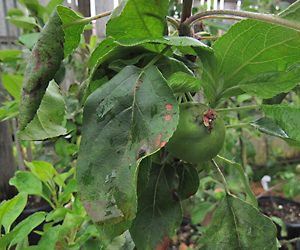 Many fruit trees are starting to show the signs of a cold, wet spring. Our first indication of the weather showed up on peach trees, in the form of peach leaf curl. Established trees of leaf curl resistant varieties like Frost, Avalon Pride, and Betty showed much more leaf curl than normal this spring. Non-resistant varieties that were sprayed to control peach leaf curl also showed more curled leaves than normal.
Many fruit trees are starting to show the signs of a cold, wet spring. Our first indication of the weather showed up on peach trees, in the form of peach leaf curl. Established trees of leaf curl resistant varieties like Frost, Avalon Pride, and Betty showed much more leaf curl than normal this spring. Non-resistant varieties that were sprayed to control peach leaf curl also showed more curled leaves than normal.
What can you do at this point if your peach tree has leaf curl? You can remove the most infected leaves. The most important action is to make sure the tree is growing vigorously, and not subject to drought stress this summer.
Apple trees were the next to show their displeasure. The past few weeks where the cold weather has alternated with warm days, powdery mildew has shown up in abundance. This fungal disease shows up as a gray to white film on the stems and new foliage. Scab is also very prevalent this spring.
The danger of these fungal diseases is twofold. Mildew can distort the new foliage significantly, and can also cause the wood to become ‘blind’, or lacking fruit buds. You can break off affected branch tips. A sulfur spray after breaking off can help keep new foliage from becoming infected. Most organic sprays will not cure mildew- this is one disease where prevention is the best action. Left to mature, the fungus can continue to spread through the tree. Affected leaves will not help support the tree’s growth.
Scab affects both the leaves and the fruit on both apples and pears. On the fruit, the fungus causes spots that become corky as the fruit matures. This damage is mostly cosmetic, although in severe cases, it can cause the fruit to crack. On the leaves, the fungus causes distortion and spotting. Affected leaves will drop early. Trees that experience this leaf drop year after year become stunted. On healthy trees, one year of scab
infection is not critical. But because some of the foliage may drop early, it is important to ‘baby’ your trees and keep them growing vigorously this summer. Fertilize if you haven’t already, and make sure there is no drought stress this summer.
Even if you did it right, and timed a delayed dormant spray as the leaves were emerging, you may still see some scab. Because of the wet and cold, the scab cycle was much longer this spring than normal.
If your trees are experiencing any of these diseases this year, it becomes more critical to control them next spring, as it is the repeated infections that can stunt your trees.

